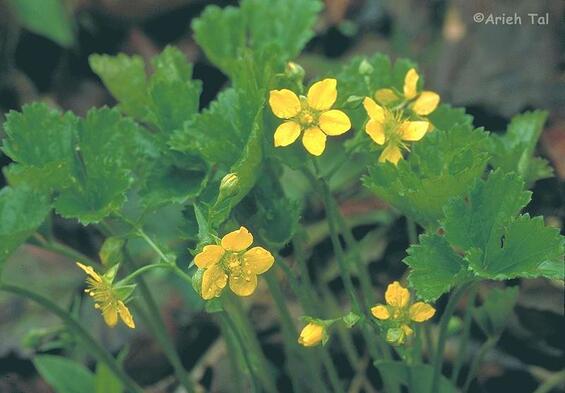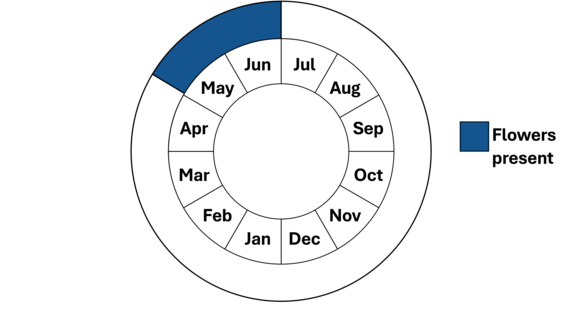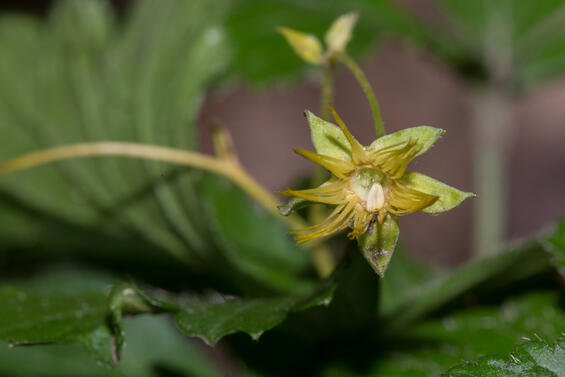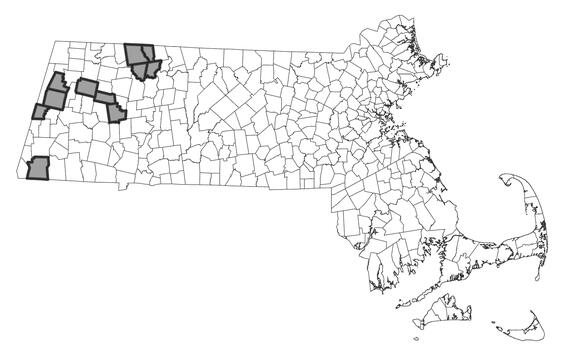- Scientific name: Geum fragarioides (Michx.) Smedmark
- Species of Greatest Conservation Need (MA State Wildlife Action Plan)
- Special Concern (MA Endangered Species Act)
Description

Photo credit: Ariel Tal
Barren strawberry (Geum fragarioides) is a low-growing, yellow woodland wildflower of the rose family (Rosaceae), known in Massachusetts from a variety of rich mesic habitats. A rhizomatous perennial herb, this species spreads through both seed and rhizome, and can form extensive colonies.
Barren strawberry grows 10- 20 cm (4–8 in) in height, with leaves arising from tough, fibrous woody rhizomes. The leaves are evergreen and long-petioled, with three wedge-shaped, shallowly lobed leaflets; the lateral leaflets are asymmetrical. The flowers are five petaled, with triangular sepals, yellow petals, and numerous stamens. The inflorescence is a cyme of few to many flowers on a long scape, approximately equal in height to the leaves. Typically, 2 to 6 achenes (dry, single-seeded fruits) are produced from each flower.
Barren strawberry somewhat resembles wild strawberry (Fragaria virginiana) and woodland strawberry (F. vesca ssp. americana). Both of these strawberry species, however, have white petaled flowers and fleshy edible fruits, and leaflets that are narrower than those of barren strawberry.
Recent research has shown that barren strawberry is part of a complex of species, including at least one European (Geum trifolium) and one Asian species (Geum ternatum). These species can be distinguished from the rare Massachusetts barren strawberry when in flower as these have an epicalyx (a whorl of modified bracts below the inflorescence of petals and sepals). The native barren strawberry does not produce an epicalyx. European barren strawberry leaflets have at least some sinuses extending greater than halfway to the midvein, versus the native barren strawberry with sinuses in its leaflets extending less than halfway to the midvein. In addition, the yellow petals of barren strawberry in Massachusetts rarely overlap each other, while those of the non-native species are wider and overlap each other.
Life cycle and behavior

Barren strawberry is a rhizomatous perennial herb that remains green all year. It flowers May through June. Fruit from barren strawberry is produced mid-June through July but is rarely observed.
Population status

Photo credit: Josh Lincoln
Barren strawberry is listed under the Massachusetts Endangered Species Act as a species of special concern. All listed species are legally protected from killing, collection, possession, or sale, and from activities that would destroy habitat and thus directly or indirectly cause mortality or disrupt critical behaviors. Barren strawberry currently has only 29 known populations (observed in the last 25 years) in Berkshire, Franklin, and Hampshire Counties, and has 7 historical populations known from herbarium records, many with insufficient information to relocate the populations.
Distribution and abundance
The documented range of barren strawberry encompasses most of eastern North America, from Quebec and New Brunswick, south to Georgia and Alabama, Minnesota, Missouri, and Arkansas. It is considered vulnerable in Indiana, Massachusetts, Minnesota; imperiled in Missouri, New Hampshire, and New Jersey; and critically imperiled in Arkansas, Connecticut, and Maine (NatureServe Explorer, 2025).

Distribution in Massachusetts. 2000-2025. Based on records in the Natural Heritage Database.
Habitat
Barren strawberry inhabits a variety of habitat types in Massachusetts, yet it has few enough populations to be of conservation concern; this indicates that there are factors besides available habitat that limit the distribution of the species. Barren strawberry is most typically found in rich, alluvial woodland terraces and seeps, but also in rich mesic forests, forested uplands bordering calcareous wetland communities, and old fields. Associated species vary greatly according to the habitat type, but often include sugar maple (Acer saccharum), white ash (Fraxinus americana), musclewood (Carpinus caroliniana), baneberries (Actaea spp.), false Solomon’s seal (Maianthemum racemosum), cinnamon fern (Osmundastrum cinnamomeum), and ostrich fern (Matteuccia struthiopteris).
Healthy habitats are vital for supporting native wildlife and plants. Explore habitats and learn about conservation and restoration in Massachusetts.
Threats
Note small bracts between larger green sepals; those are the epi-calyx. If you find these on a barren strawberry plant, it is a non-native introduced species. If growing wild, please let NHESP know via Heritage Hub. Photo by Matthew Charpentier.
Some populations of barren strawberry are threatened by invasion of exotic plant species such as garlic mustard (Alliaria petiolata), Japanese barberry (Berberis thunbergii), Morrow’s honeysuckle (Lonicera morrowii), and common buckthorn (Rhamnus cathartica). These species can dominate the vegetation cover and effectively outcompete barren strawberry. Heavy recreational uses, such as hiking, mountain biking, and off-road vehicles use, in barren strawberry habitat can cause physical damage to plants, compaction or erosion of the soil, and increase invasive plants in the habitat. Increased storm intensity and heavy rains in the northeast may threaten populations of barren strawberry through erosion of habitat during flood events. Finally, forestry activities can provide additional light, but may also damage the species physically, cause erosion, and increase shading by other plants, both native and introduced non-natives.
Botanists have documented that the non-native European (Geum trifolium) and Asian species (Geum ternatum) are sold in the horticultural trade as the native barren strawberry (Nichols et al., 2022). Populations of these species have been documented as escaped in Massachusetts and Vermont. It is not known whether the non-native species are capable of hybridizing with the native rare species; this possibility poses a threat to the viability of populations of native barren strawberry populations in the northeast.
Conservation
All rare species need occasional monitoring for protection of the species. Each population of this species should be monitored every 10 to 15 years and its habitat assessed. The best time to survey for it is during flowering in May or June. This is a species that spreads rhizomatously and can form patches which are all one plant. It best to report it as ramets, or if a large patch, the area in square feet or square meters that the patch covers. Any survey should include a close inspection of the flowers and a check for an epicalyx (little bracts just underneath the flower’s sepals) which would indicate it is a non-native species.
All active management of rare plant populations (including invasive species removal) is subject to review under the Massachusetts Endangered Species Act and should be planned in close consultation with the Massachusetts Natural Heritage & Endangered Species Program (NHESP). Management activities might include control of invasive plants, cutting to allow in more light, moving a trail to protect the population. All forestry activities within barren strawberry habitat are subject to review to protect these rare plants.
Known populations of barren strawberry should be visited while in flower to determine whether they are the native species (G. fragarioides) or the non-native European (Geum trifolium) and Asian species (Geum ternatum). It is not known if these species can hybridize with the barren strawberry. Please notify NHESP of observations of barren strawberry using the Heritage Hub web application.
Acknowledgement
MassWildlife acknowledges the expertise of Matt Charpentier, who contributed substantially to the development of this fact sheet.
References
Haines, Arthur. New England Wild Flower Society’s Flora Novae Angliae: A Manual for the Identification of Native and Naturalized Higher Vascular Plants of New England. 2011. New Haven: Yale University Press.
NatureServe. 2025. NatureServe Network Biodiversity Location Data accessed through NatureServe Explorer [web application]. NatureServe, Arlington, Virginia. Available https://explorer.natureserve.org/Taxon/ELEMENT_GLOBAL.2.136156/Waldsteinia_fragarioides Accessed 3/14/2025.
Nichols, William, Alice Schori, Amy Lamb, and Arthur Haines. Geum fragarioides and Geum ternatum (Rosaceae) in New England. 2022. Rhodora.
Phipps, Jmaes. Waldsteinia. Flora of North America North of Mexico [Online]. http://floranorthamerica.org/Waldsteinia
POWO (2025). "Plants of the World Online. Facilitated by the Royal Botanic Gardens, Kew. Published on the Internet; https://powo.science.kew.org/ Retrieved 3/14/2025."
Staudinger, M.D., A.V. Karmalkar, K. Terwilliger, K. Burgio, A. Lubeck, H. Higgins, T. Rice, T.L. Morelli, A. D'Amato. 2024. A regional synthesis of climate data to inform the 2025 State Wildlife Action Plans in the Northeast U.S. DOI Northeast Climate Adaptation Science Center Cooperator Report. 406 p. https://doi.org/10.21429/t352-9q86
Contact
| Date published: | April 29, 2025 |
|---|